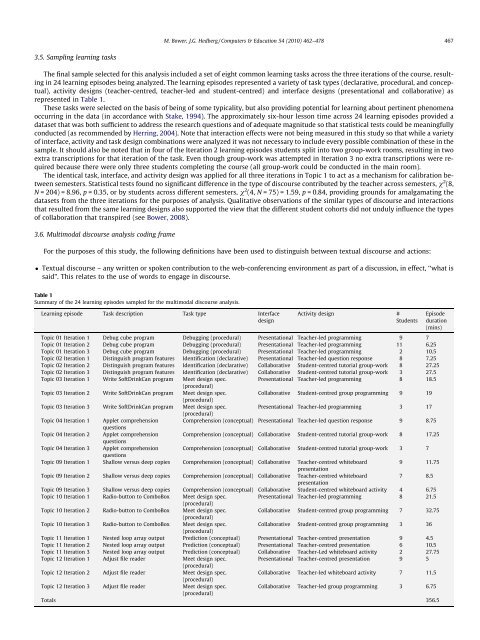A quantitative multimodal discourse analysis of ... - Anitacrawley.net
A quantitative multimodal discourse analysis of ... - Anitacrawley.net
A quantitative multimodal discourse analysis of ... - Anitacrawley.net
You also want an ePaper? Increase the reach of your titles
YUMPU automatically turns print PDFs into web optimized ePapers that Google loves.
M. Bower, J.G. Hedberg / Computers & Education 54 (2010) 462–478 4673.5. Sampling learning tasksThe final sample selected for this <strong>analysis</strong> included a set <strong>of</strong> eight common learning tasks across the three iterations <strong>of</strong> the course, resultingin 24 learning episodes being analyzed. The learning episodes represented a variety <strong>of</strong> task types (declarative, procedural, and conceptual),activity designs (teacher-centred, teacher-led and student-centred) and interface designs (presentational and collaborative) asrepresented in Table 1.These tasks were selected on the basis <strong>of</strong> being <strong>of</strong> some typicality, but also providing potential for learning about pertinent phenomenaoccurring in the data (in accordance with Stake, 1994). The approximately six-hour lesson time across 24 learning episodes provided adataset that was both sufficient to address the research questions and <strong>of</strong> adequate magnitude so that statistical tests could be meaningfullyconducted (as recommended by Herring, 2004). Note that interaction effects were not being measured in this study so that while a variety<strong>of</strong> interface, activity and task design combinations were analyzed it was not necessary to include every possible combination <strong>of</strong> these in thesample. It should also be noted that in four <strong>of</strong> the Iteration 2 learning episodes students split into two group-work rooms, resulting in twoextra transcriptions for that iteration <strong>of</strong> the task. Even though group-work was attempted in Iteration 3 no extra transcriptions were requiredbecause there were only three students completing the course (all group-work could be conducted in the main room).The identical task, interface, and activity design was applied for all three iterations in Topic 1 to act as a mechanism for calibration betweensemesters. Statistical tests found no significant difference in the type <strong>of</strong> <strong>discourse</strong> contributed by the teacher across semesters, v 2 (8,N = 204) = 8.96, p = 0.35, or by students across different semesters, v 2 (4, N = 75) = 1.59, p = 0.84, providing grounds for amalgamating thedatasets from the three iterations for the purposes <strong>of</strong> <strong>analysis</strong>. Qualitative observations <strong>of</strong> the similar types <strong>of</strong> <strong>discourse</strong> and interactionsthat resulted from the same learning designs also supported the view that the different student cohorts did not unduly influence the types<strong>of</strong> collaboration that transpired (see Bower, 2008).3.6. Multimodal <strong>discourse</strong> <strong>analysis</strong> coding frameFor the purposes <strong>of</strong> this study, the following definitions have been used to distinguish between textual <strong>discourse</strong> and actions: Textual <strong>discourse</strong> – any written or spoken contribution to the web-conferencing environment as part <strong>of</strong> a discussion, in effect, ‘‘what issaid”. This relates to the use <strong>of</strong> words to engage in <strong>discourse</strong>.Table 1Summary <strong>of</strong> the 24 learning episodes sampled for the <strong>multimodal</strong> <strong>discourse</strong> <strong>analysis</strong>.Learning episode Task description Task type InterfacedesignActivity design #StudentsTopic 01 Iteration 1 Debug cube program Debugging (procedural) Presentational Teacher-led programming 9 7Topic 01 Iteration 2 Debug cube program Debugging (procedural) Presentational Teacher-led programming 11 6.25Topic 01 Iteration 3 Debug cube program Debugging (procedural) Presentational Teacher-led programming 2 10.5Topic 02 Iteration 1 Distinguish program features Identification (declarative) Presentational Teacher-led question response 8 7.25Topic 02 Iteration 2 Distinguish program features Identification (declarative) Collaborative Student-centred tutorial group-work 8 27.25Topic 02 Iteration 3 Distinguish program features Identification (declarative) Collaborative Student-centred tutorial group-work 3 27.5Topic 03 Iteration 1 Write S<strong>of</strong>tDrinkCan program Meet design spec.Presentational Teacher-led programming 8 18.5(procedural)Topic 03 Iteration 2 Write S<strong>of</strong>tDrinkCan program Meet design spec.Collaborative Student-centred group programming 9 19(procedural)Topic 03 Iteration 3 Write S<strong>of</strong>tDrinkCan program Meet design spec.Presentational Teacher-led programming 3 17(procedural)Topic 04 Iteration 1 Applet comprehension Comprehension (conceptual) Presentational Teacher-led question response 9 8.75questionsTopic 04 Iteration 2 Applet comprehension Comprehension (conceptual) Collaborative Student-centred tutorial group-work 8 17.25questionsTopic 04 Iteration 3 Applet comprehension Comprehension (conceptual) Collaborative Student-centred tutorial group-work 3 7questionsTopic 09 Iteration 1 Shallow versus deep copies Comprehension (conceptual) Collaborative Teacher-centred whiteboard9 11.75presentationTopic 09 Iteration 2 Shallow versus deep copies Comprehension (conceptual) Collaborative Teacher-centred whiteboard7 8.5presentationTopic 09 Iteration 3 Shallow versus deep copies Comprehension (conceptual) Collaborative Student-centred whiteboard activity 4 6.75Topic 10 Iteration 1 Radio-button to ComboBox Meet design spec.Presentational Teacher-led programming 8 21.5(procedural)Topic 10 Iteration 2 Radio-button to ComboBox Meet design spec.Collaborative Student-centred group programming 7 32.75(procedural)Topic 10 Iteration 3 Radio-button to ComboBox Meet design spec.Collaborative Student-centred group programming 3 36(procedural)Topic 11 Iteration 1 Nested loop array output Prediction (conceptual) Presentational Teacher-centred presentation 9 4.5Topic 11 Iteration 2 Nested loop array output Prediction (conceptual) Presentational Teacher-centred presentation 6 10.5Topic 11 Iteration 3 Nested loop array output Prediction (conceptual) Collaborative Teacher-Led whiteboard activity 2 27.75Topic 12 Iteration 1 Adjust file reader Meet design spec.Presentational Teacher-centred presentation 9 5(procedural)Topic 12 Iteration 2 Adjust file reader Meet design spec.Collaborative Teacher-led whiteboard activity 7 11.5(procedural)Topic 12 Iteration 3 Adjust file reader Meet design spec.Collaborative Teacher-led group programming 3 6.75(procedural)Totals 356.5Episodeduration(mins)
















